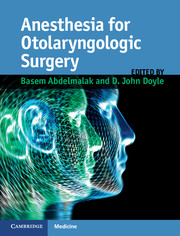50 results
Chapter 26 - Ear, Nose and Throat Surgery: Airway Management
- from Section 2 - Airway Management: Clinical Settings and Subspecialties
-
-
- Book:
- Core Topics in Airway Management
- Published online:
- 03 October 2020
- Print publication:
- 03 December 2020, pp 223-242
-
- Chapter
- Export citation
Chapter 12 - Management of anterior mediastinal mass
-
-
- Book:
- Cases in Emergency Airway Management
- Published online:
- 05 December 2015
- Print publication:
- 26 November 2015, pp 89-93
-
- Chapter
- Export citation
Preface
-
-
- Book:
- Anesthesia for Otolaryngologic Surgery
- Published online:
- 05 November 2012
- Print publication:
- 18 October 2012, pp xv-xvi
-
- Chapter
- Export citation
Section 1 - Introduction
-
- Book:
- Anesthesia for Otolaryngologic Surgery
- Published online:
- 05 November 2012
- Print publication:
- 18 October 2012, pp 1-112
-
- Chapter
- Export citation
Chapter 31 - Anesthesia for therapeutic bronchoscopic procedures
- from Section 5 - Anesthesia for bronchoscopic surgery
-
-
- Book:
- Anesthesia for Otolaryngologic Surgery
- Published online:
- 05 November 2012
- Print publication:
- 18 October 2012, pp 309-320
-
- Chapter
- Export citation
Contents
-
- Book:
- Anesthesia for Otolaryngologic Surgery
- Published online:
- 05 November 2012
- Print publication:
- 18 October 2012, pp vii-viii
-
- Chapter
- Export citation
Chapter 16 - Anesthesia for head and neck flap reconstructive surgery
- from Section 3 - Anesthesia for head and neck surgery
-
-
- Book:
- Anesthesia for Otolaryngologic Surgery
- Published online:
- 05 November 2012
- Print publication:
- 18 October 2012, pp 151-162
-
- Chapter
- Export citation
Index
-
- Book:
- Anesthesia for Otolaryngologic Surgery
- Published online:
- 05 November 2012
- Print publication:
- 18 October 2012, pp 346-353
-
- Chapter
- Export citation
Section 3 - Anesthesia for head and neck surgery
-
- Book:
- Anesthesia for Otolaryngologic Surgery
- Published online:
- 05 November 2012
- Print publication:
- 18 October 2012, pp 143-244
-
- Chapter
- Export citation
Section 6 - Anesthesia for Pediatric ENT Surgery
-
- Book:
- Anesthesia for Otolaryngologic Surgery
- Published online:
- 05 November 2012
- Print publication:
- 18 October 2012, pp 321-345
-
- Chapter
- Export citation
Anesthesia for Otolaryngologic Surgery - Title page
-
-
- Book:
- Anesthesia for Otolaryngologic Surgery
- Published online:
- 05 November 2012
- Print publication:
- 18 October 2012, pp iii-iii
-
- Chapter
- Export citation
Copyright page
-
- Book:
- Anesthesia for Otolaryngologic Surgery
- Published online:
- 05 November 2012
- Print publication:
- 18 October 2012, pp iv-iv
-
- Chapter
- Export citation
Chapter 20 - Anesthesia for Zenker's diverticulectomy
- from Section 3 - Anesthesia for head and neck surgery
-
-
- Book:
- Anesthesia for Otolaryngologic Surgery
- Published online:
- 05 November 2012
- Print publication:
- 18 October 2012, pp 195-202
-
- Chapter
- Export citation
Chapter 30 - Anesthesia for diagnostic bronchoscopic procedures
- from Section 5 - Anesthesia for bronchoscopic surgery
-
-
- Book:
- Anesthesia for Otolaryngologic Surgery
- Published online:
- 05 November 2012
- Print publication:
- 18 October 2012, pp 297-308
-
- Chapter
- Export citation
Contributors
-
-
- Book:
- Anesthesia for Otolaryngologic Surgery
- Published online:
- 05 November 2012
- Print publication:
- 18 October 2012, pp xi-xiv
-
- Chapter
- Export citation
Section 5 - Anesthesia for bronchoscopic surgery
-
- Book:
- Anesthesia for Otolaryngologic Surgery
- Published online:
- 05 November 2012
- Print publication:
- 18 October 2012, pp 297-320
-
- Chapter
- Export citation
Anesthesia for Otolaryngologic Surgery - Half title page
-
- Book:
- Anesthesia for Otolaryngologic Surgery
- Published online:
- 05 November 2012
- Print publication:
- 18 October 2012, pp i-ii
-
- Chapter
- Export citation
Section 4 - Anesthesia for laryngotracheal surgery
-
- Book:
- Anesthesia for Otolaryngologic Surgery
- Published online:
- 05 November 2012
- Print publication:
- 18 October 2012, pp 245-296
-
- Chapter
- Export citation

Anesthesia for Otolaryngologic Surgery
-
- Published online:
- 05 November 2012
- Print publication:
- 18 October 2012
Section 2 - Anesthesia for nasal, sinus and pituitary surgery
-
- Book:
- Anesthesia for Otolaryngologic Surgery
- Published online:
- 05 November 2012
- Print publication:
- 18 October 2012, pp 113-142
-
- Chapter
- Export citation



